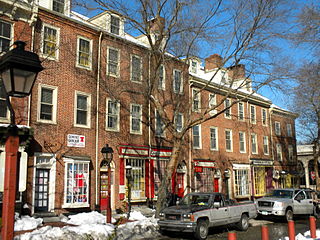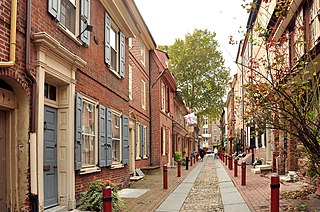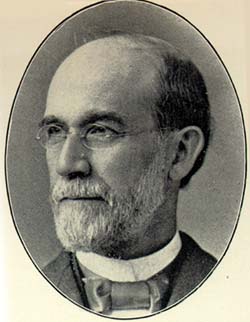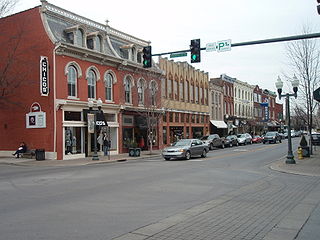
Bellefonte is a borough in, and the county seat of, Centre County, Pennsylvania, United States. It is approximately twelve miles northeast of State College and is part of the State College, Pennsylvania metropolitan statistical area. The borough population was 6,187 at the 2010 census. It houses the Centre County Courthouse, located downtown on the diamond. Bellefonte has also been home to five of Pennsylvania's governors, as well as two other governors. All seven are commemorated in a monument located at Talleyrand Park.

Sunbury, Pennsylvania, is a city and the county seat of Northumberland County. Located in the Susquehanna Valley, Sunbury is positioned on the east bank of the Susquehanna River.

Springfield is a historic neighborhood of Jacksonville, Florida, United States, located to the north of downtown. Established in 1869, it experienced its greatest growth from the early 1880s through the 1920s. The Springfield Historic District is listed in the National Register of Historic Places, and contains some of the city's best examples of 19th and early 20th century architecture.

Old City is a neighborhood in Center City, Philadelphia, Pennsylvania, United States, near the Delaware River waterfront. It is home to Independence National Historical Park, a dense section of historic landmarks including Independence Hall, the Liberty Bell, the First Bank of the United States, the Second Bank of the United States, and Carpenters' Hall. It also includes historic streets such as Elfreth's Alley, dating back to 1703.

Society Hill is a historic neighborhood in Center City Philadelphia, Pennsylvania, United States, with a population of 6,215 as of the 2010 United States Census. Settled in the early 1680s, Society Hill is one of the oldest residential neighborhoods in Philadelphia. After urban decay developed between the late 19th and early 20th centuries, an urban renewal program began in the 1950s, restoring the area and its many historic buildings. Society Hill has since become one of the most expensive neighborhoods with the highest average income and second-highest real estate values in Philadelphia. Society Hill's historic colonial architecture, along with planning and restoration efforts, led the American Planning Association to designate it, in 2008, as one of the great American neighborhoods and a good example of sustainable urban living.
Augusta Township was one of the seven original townships of Northumberland County, Pennsylvania in the United States. It was formed in 1772 and ceased to exist on April 13, 1846 when it was divided into Upper Augusta and Lower Augusta townships.

Carpenters' Hall, in Independence National Historical Park in Philadelphia, Pennsylvania, is the official birthplace of the Commonwealth of Pennsylvania and a key meeting place in the early history of the United States. Completed in 1775, the two-story brick meeting hall was built for and still privately owned by the Carpenters' Company of the City and County of Philadelphia, the country's oldest extant craft guild.

Samuel Sloan was a Philadelphia-based architect and best-selling author of architecture books in the mid-19th century. He specialized in Italianate villas and country houses, churches, and institutional buildings. His most famous building—the octagonal mansion "Longwood" in Natchez, Mississippi—is unfinished; construction was abandoned during the American Civil War.

G. W. & W. D. Hewitt was a prominent architectural firm in the eastern United States at the turn of the twentieth century. It was founded in Philadelphia in 1878, by brothers George Wattson Hewitt (1841–1916) and William Dempster Hewitt (1847–1924), both members of the American Institute of Architects. The firm specialized in churches, hotels and palatial residences, especially crenelated mansions, such as Maybrook (1881), Druim Moir (1885–86) and Boldt Castle (1900–04).

Historic districts in the United States are designated historic districts recognizing a group of buildings, archaeological resources, or other properties as historically or architecturally significant. Buildings, structures, objects, and sites within a historic district are normally divided into two categories, contributing and non-contributing. Districts vary greatly in size and composition: a historic district could comprise an entire neighborhood with hundreds of buildings, or a smaller area with just one or a few resources.

In the law regulating historic districts in the United States, a contributing property or contributing resource is any building, object, or structure which adds to the historical integrity or architectural qualities that make the historic district significant. Government agencies, at the state, national, and local level in the United States, have differing definitions of what constitutes a contributing property but there are common characteristics. Local laws often regulate the changes that can be made to contributing structures within designated historic districts. The first local ordinances dealing with the alteration of buildings within historic districts was enacted in Charleston, South Carolina in 1931.

Addison Hutton (1834–1916) was a Philadelphia architect who designed prominent residences in Philadelphia and its suburbs, plus courthouses, hospitals, and libraries, including the Ridgway Library, now Philadelphia High School for the Creative and Performing Arts, and the Historical Society of Pennsylvania. He made major additions to the campuses of Westtown School, George School, Swarthmore College, Bryn Mawr College, Haverford College, and Lehigh University.

This is a list of the National Register of Historic Places listings in Northumberland County, Pennsylvania.

This is a list of the National Register of Historic Places listings in Center City, Philadelphia.

College Hill is a residential neighborhood in Easton, Pennsylvania. The neighborhood is situated on the hill overlooking downtown Easton which was once known as Mount Lafayette, and before that, Mount Washington. Lafayette College borders the neighborhood on its southwest side. The northern boundary of the neighborhood is Forks Township. The boundary lies along Chestnut Ridge, a steep hill that rises to 700 feet. College Hill has a total of three historic religious institutional buildings, three parks, and the remains of Rinek Mansion grounds.

This is a list of the Davenport Register of Historic Properties in Davenport, Iowa, United States.

Franklin Historic District is a historic district in Franklin, Tennessee that was listed on the National Register of Historic Places in 1972. It was created to preserve historic commercial and residential architecture in a 16-block area of the original, downtown Franklin around the north, west, and south of the town square.

The Annville National Historic District is a national historic district located in Annville, Lebanon County, Pennsylvania, United States. It is one of two historic districts in the community of Annville, and was added to the National Register of Historic Places in 1979.

The Lisbon Inn, formerly The Moulton, is a historic former hotel building on United States Route 302 in Lisbon, New Hampshire. Located at the southern end of Lisbon's central business district, the 1901 three story wood-frame building is an imposing presence, with Queen Anne-style pyramidal roof turrets at the corners of the main facade. The front of the building has two stories of porches with Colonial Revival styling.
The City of Seattle Landmarks Preservation Board is responsible for designating and preserving structures of historical importance in Seattle, Washington. The board recommends actions to the Seattle City Council, which fashions these into city ordinances with the force of law. The board is part of the city's Department of Neighborhoods.
























